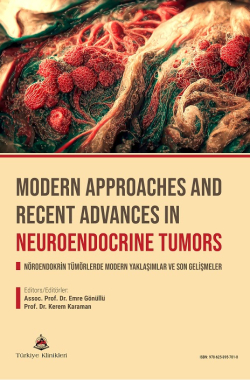PROGNOSIS AND QUALITY OF LIFEIN GASTROENTEROPANCREATIC NEUROENDOCRINE TUMORS
Özlem Doğan
Adıyaman University Training and Research Hospital, Department of Medical Oncology, Adıyaman, Türkiye
Doğan Ö. Prognosis and Quality of Life in Gastroenteropancreatic Neuroendocrine Tumors. In: Gönüllü E, Karaman K, editors. Modern Approaches and Recent Advances in Neuroendocrine Tumors. 1st ed. Ankara: Türkiye Klinikleri; 2025. p.201-206.
ABSTRACT
Gastroenteropancreatic neuroendocrine tumors (GEP-NETs) are rare neoplasms with a wide spectrum of biological behavior, ranging from low-grade, slow-growing forms to aggressive and metastatic variants. Prognosis is primarily influenced by tumor stage, grade, Ki-67 proliferation index, and primary tumor localization. The World Health Organization (WHO) classification provides a standardized system for categorizing GEP-NETs based on histological features and proliferation rates, guiding both therapeutic decisions and survival expectations. While well-differentiated, low-grade tumors are generally associated with favorable outcomes, poorly differentiated or high-grade neuroendocrine carcinomas (NECs) are linked to significantly worse survival. In addition to disease progression, GEP-NET-related hormonal symptoms and treatment-associated adverse effects can negatively impact patients’ quality of life. Therefore, individualized treatment strategies and a multidisciplinary care approach are essential for improving both clinical outcomes and quality of life in these patients.
Keywords: Gastroenteropancreatic neuroendocrine tumor; Neuroendocrine carcinoma; Carcinoid syndrome; Metastasis; Prognosis
Kaynak Göster
Referanslar
- Meeker A, Heaphy C. Gastroenteropancreatic endocrine tumors. Molecular and cellular endocrinology. 2014;386(12):101-120. [Crossref] [PubMed]
- Pathak S, Starr JS, Halfdanarson T, Sonbol MB. Understanding the increasing incidence of neuroendocrine tumors. Expert Review of Endocrinology & Metabolism. 2023;18(5):377-385. [Crossref] [PubMed]
- Staal FC, Aalbersberg EA, van der Velden D, Wilthagen EA, Tesselaar ME, Beets-Tan RG, et al. GEP-NET radiomics: a systematic review and radiomics quality score assessment. European Radiology. 2022;32(10):7278-7294. [Crossref] [PubMed]
- Mafficini A, Scarpa A. Genetics and epigenetics of gastroenteropancreatic neuroendocrine neoplasms. Endocrine reviews. 2019;40(2):506-536. [Crossref] [PubMed] [PMC]
- Clement DS, van Leerdam ME, Tesselaar ME, Cananea E, Martin W, Weickert MO, et al. The global leadership into malnutrition criteria reveals a high percentage of malnutrition which influences overall survival in patients with gastroenteropancreatic neuroendocrine tumours. Journal of Neuroendocrinology. 2024;36(4):e13376. [Crossref] [PubMed]
- Sorbye H, Baudin E, Borbath I, Caplin M, Chen J, Cwikla JB, et al. Unmet needs in high-grade gastroenteropancreatic neuroendocrine neoplasms (WHO G3). Neuroendocrinology. 2019;108(1):54-62. [Crossref] [PubMed]
- Elvebakken H, Perren A, Scoazec J-Y, Tang LH, Federspiel B, Klimstra DS, et al. A consensus-developed morphological re-evaluation of 196 high-grade gastroenteropancreatic neuroendocrine neoplasms and its clinical correlations. Neuroendocrinology. 2021;111(9):883-894. [Crossref] [PubMed]
- Keutgen XM, Schadde E, Pommier RF, Halfdanarson TR, Howe JR, Kebebew E. Metastatic neuroendocrine tumors of the gastrointestinal tract and pancreas: A surgeon's plea to centering attention on the liver. Elsevier; 2018:232-235. [Crossref] [PubMed]
- Pozas J, Alonso-Gordoa T, San Román M, Santoni M, Thirlwell C, Grade E, et al. Novel therapeutic approaches in GEP-NETs based on genetic and epigenetic alterations. Biochimica et Biophysica Acta (BBA)-Reviews on Can cer. 2022;1877(5):188804. [Crossref] [PubMed]
- Zikusoka MN, Kidd M, Eick G, Latich I, Modlin IM. The molecular genetics of gastroenteropancreatic neuroendocrine tumors. Cancer: Interdisciplinary International Journal of the American Cancer Society. 2005;104(11):2292-2309. [Crossref] [PubMed]
- Agrícola JMC. Genetic profile of gastroenteropancreatic neuroendocrine tumors. Endocrinologia y nutricion: organo de la Sociedad Espanola de Endocrinologia y Nutricion. 2009;56:16-19. [Crossref] [PubMed]
- Tan B, Zhang B, Chen H. Gastroenteropancreatic neuroendocrine neoplasms: epidemiology, genetics, and treatment. Frontiers in Endocrinology. 2024;15:1424839. [Crossref] [PubMed] [PMC]
- Watson C, Tallentire CW, Ramage JK, Srirajaskanthan R, Leeuwenkamp OR, Fountain D. Quality of life in patients with gastroenteropancreatic tumours: A systematic literature review. World Journal of Gastroenterology. 2020;26(25):3686. [Crossref] [PubMed] [PMC]
- Gade AK, Olariu E, Douthit NT. Carcinoid syndrome: a review. Cureus. 2020;12(3). [Crossref]
- Boutzios G, Kaltsas G. Clinical syndromes related to gastrointestinal neuroendocrine neoplasms. Neuroendocrine Tumors: A Multidisciplinary Approach. 2015;44:40-57. [Crossref] [PubMed]
- Meng Y, McCarthy G, Berthon A, Dinet J. Patient-reported health state utilities in metastatic gastroenteropancreatic neuroendocrine tumours-an analysis based on the CLARINET study. Health and quality of life outcomes. 2017;15:1-9. [Crossref] [PubMed] [PMC]
- Jiménez-Fonseca P, Carmona-Bayonas A, Martín-Pérez E, Crespo G, Serrano R, Llanos M, et al. Health-related quality of life in well-differentiated metastatic gastroenteropancreatic neuroendocrine tumors. Cancer and Metastasis Reviews. 2015;34:381-400. [Crossref] [PubMed]
- Benavent M, Sastre J, Escobar IG, Segura A, Capdevila J, Carmona A, et al. Physician-perceived utility of the EORTC QLQ-GINET21 questionnaire in the treatment of patients with gastrointestinal neuroendocrine tumours: a multicentre, cross-sectional survey (QUALINETS). Health and Quality of Life Outcomes. 2021;19:1-11. [Crossref] [PubMed] [PMC]

